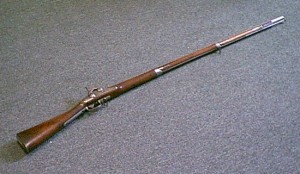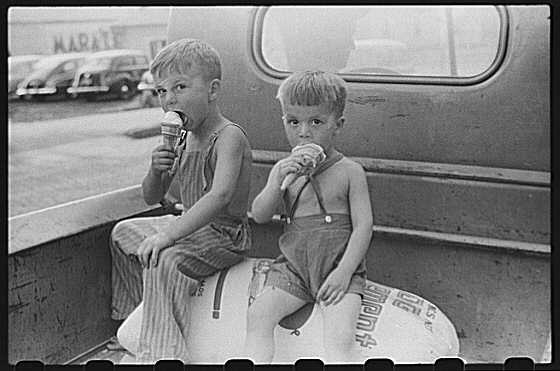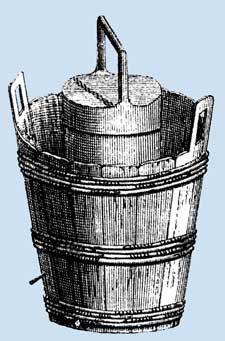During the nineteenth century, firearm technology experienced a series of incredible technological advances. The smooth bore, round-ball musket, which had been favored for centuries of warfare, was replaced by the grooved barrels and cylindro-conical rounds of the rifle. However, during the Civil War, a middle ground between the two styles was favored by the Union army: the rifle-musket, of which Springfield and Enfield models were the most commonly-seen. These weapons, which married musket-style barrel lengths with barrel rifling, represented a leap forward in accuracy, as well as battlefield reliability. Unfortunately, battlefield tactics initially lagged behind the new technology, which meant that increasingly-accurate rifle-muskets took a heavy toll on foot soldiers deployed in archaic battle formations.
The closing years of the eighteenth century yielded an innovation in firearms technology: the digging of grooves into musket barrels. The grooves, dubbed rifling, put a spin on the discharged round: this increased the effective accurate range of the weapon. However, these weapons continued to fire round bullets until the middle of the nineteenth century. According to an article by Paul Dougherty and Major Herbert Collins, “Although accuracy could be improved with the use of a rifled barrel, the tit of the bullet/barrel needed to be tight to impart a spin on the projectile. This made reloading too slow for the standard military arm” (Wound Ballistics 403). Due to the requirement of being small enough to quickly slide down the rifled barrel, the accuracy of the bullets was hampered. However, in 1847, French officer Captain Claude Minie developed a new sort of round that seemed to solve this loading problem. He created a bullet shaped like a cylinder that tapered to a cone at the front end. The base of the bullet was hollow, which, according to historian Charles Worman, expanded “by the force of the exploding gunpowder, causing the bullet base to expand and fill and grip the rifling grooves” (Firearms in American History 71). Harper’s Ferry assistant master armorer, and later superintendent of Confederate armories, James Burton later improved on this design, but history has given the bullet the moniker of “Minie ball.” The Minie ball essentially solved the aforementioned bullet and barrel problems and truly took advantage of barrel rifling. In the Union army during the Civil War, these advances were most often made apparent through the use of Springfield M1861 and Enfield .577 rifle-muskets.
The name of the M1861 model gives the year of the Springfield model’s creation, but it was largely based on the company’s M1855. Both models boasted forty inch, round barrels with three rifling grooves and shot a .58 caliber bullet. The gun’s caliber was a compromise between two previously-used sizes; .54 caliber rounds, which avoided excessive recoil but lacked accuracy, and the increased accuracy of .69 caliber rounds, which was counterbalanced by the excessive weight required for guns to be able to fire them. It could also be fitted with an intimidating triangular bayonet. However, despite contracting private gun makers produce M1861s, the Union army still faced a shortage of up-to-date firearms. For example, although Lincoln’s government contracted more than a million rifle-muskets in 1861, meaningful quantities of firearms did not begin to arrive in soldiers hands until two years later. In order to fulfill these weapon needs, muskets and rifles were purchased from a large number of foreign sources.

Springfield M1861
Of these, the British “long” Enfield Pattern 1853 was the most sought-after. Perhaps the secret to its success with Union soldiers stemmed from its similarities to the Springfield models: the Enfield had a thirty-nine inch, round barrel, with three grooves serving as rifling. The Enfield officially shot a .577 caliber round which, according to Louis Garavaglia and Charles Worman’s Firearms of the American West, “would also work in the U.S. .58 caliber rifles. Depending on actual bullet diameter, U.S. .58 caliber Minie bullets… would work in the Enfields as long as the bore was reasonably clean” (167). Both the Springfield and the Enfield were muzzle-loaders, meaning that a rod was required to push single rounds into place in the barrel before they could be fired.

Enfield 1853
Both the Springfield models and the Enfield expelled their single rounds with a percussion cap, described in Firearms in American History as “a small copper cup with the fulminate inside its base covered with a tin foil disk and sealed with a bit of shellac to make it waterproof” (44). These caps worked much better in poor weather than did the previously-favored flintlock system, although some on the frontier were reluctant to abandon their tried-and-true mechanism. The individual cartridges, containing the round and necessary gunpowder, were sealed in paper. When the guns were loaded, the paper was torn open in some way and the powder was poured down the barrel. An amusing legend states that, in the early stages of the war, four good front teeth were required for enlistment. This way, the soldier would be able to quickly bite open cartridges, instead of having to open them with his fingers (Firearms in American History 109). Next, a ramrod, which had to be withdrawn and replaced, was used to shove the round down. Finally, a percussion cap was placed on the gun’s nipple, the gun was cocked, and it was ready to be fired. Firearms in American History gives the normal rate of fire for these guns as “about three rounds per minute under good conditions” (109). Unfortunately, due to the powder residue left by each Minie ball, the rifle muskets would become difficult to fire after around twenty shots if they were not cleaned. Here is a video of a Civil War-era rifle was fired:
These favorable qualities contributed to the rifle-musket’s effective range far out-doing previously-favored smoothbore weapons. Unfortunately, since these forward strides had been made so close to the advent of the Civil War, the leaders on both sides did not immediately recognize the pitfalls of employing smoothbore-era military tactics in the age of Minie balls and rifled barrels. Smoothbore weapons, such as those employed in the Revolutionary War, only had an effective range of about fifty yards, according to Dougherty and Collins. In contrast, rifle-muskets had an effective range of between 500 and 1,000 yards. With that increased accuracy in mind, it is easy to see how the attrition battle of lining troops up less than 100 yards apart to shoot at one another was less effective in 1863 than in the previous century. However, mechanically speaking, these Springfield and Enfield rifle-muskets of the Civil War performed excellently in the workhorse role they were given in the war. Unfortunate for them was that the march of technology did not stop with them, and both models were soon rendered obsolete.
Works Cited
1853 3-Band Enfield Musket, .58 Caliber. Taylor’s & Co., Inc., Winchester. Taylor’s & Co., Inc.. Web. 20 October 2009.
Dougherty, Paul and Herbert Eidt. “Wound Ballistics: Minié Ball vs. Full Metal Jacketed Bullets—A Comparison of Civil War and Spanish-American War Firearms.” Military Medicine 174, 4:403 (2009): 403-407. Academic Search Complete. Web. 16 Oct. 2009.
Garavaglia, Louis and Charles Worman. Firearms of the American West: 1803-1865. Albuquerque: University of New Mexico Press, 1984. Print.
Springfield 1861. Myra Museum, Grand Forks. Civil War History: The Blog Between the States. Web. 20 October 2009.
Worman, Charles. Firearms in American History. Yardly: Westholme, 2007. Print.





















